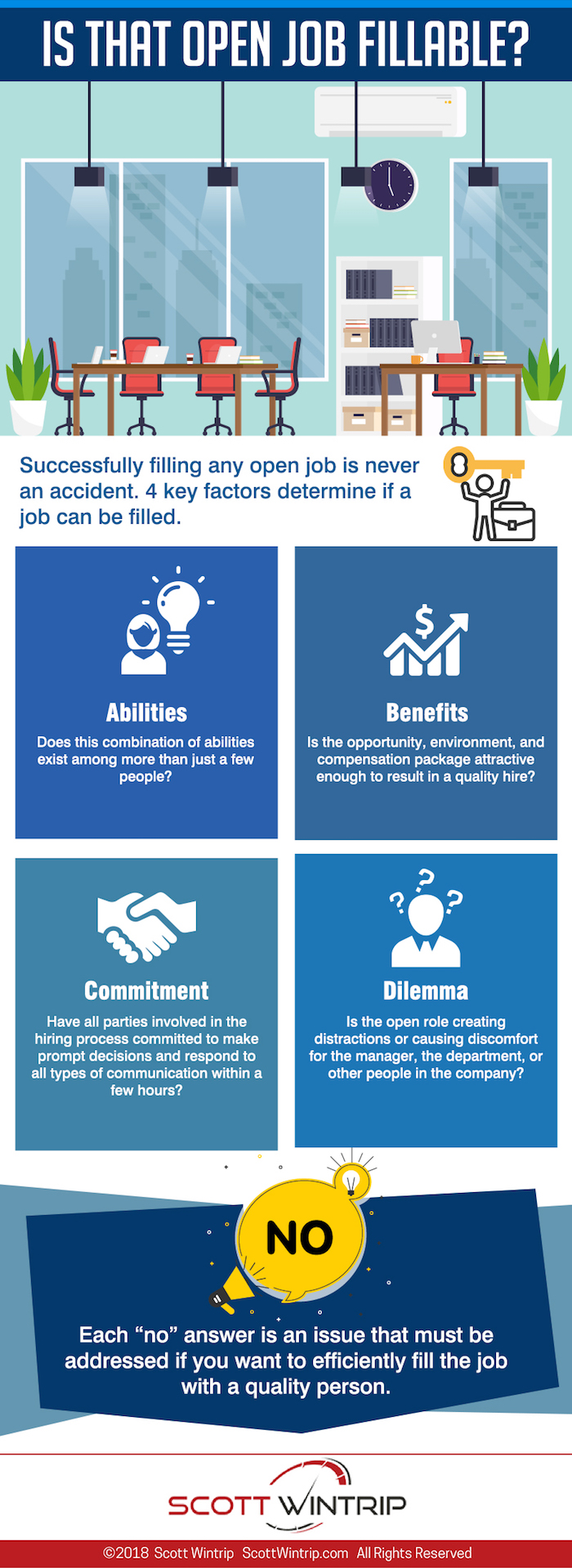You have a job to fill. What do you do first? Search your talent database? Post it online? Run an ad? The answer: none of these.
The first step, one that is often overlooked, is to determine if the job is fillable. Many jobs cannot be filled, and the cause isn’t the skills shortage.
During the past eight months, I reviewed 3500 open jobs. The roles included full and part-time positions along with temporary and contract assignments. Spanning 600 employers, filling these roles was tasked to in-house HR departments, talent acquisition teams, external recruitment agencies, or a combination of these.
65% of the jobs couldn’t be filled.
These jobs remained open because of one or more of four issues. Once these were addressed, unfillable jobs were filled swiftly.
Here are those four issues and the questions you need to ask about each one. (I refer to these as practicing your ABCD’s.)

Abilities
Ever seen a purple squirrel? I did. Once. It was a picture online that someone had Photoshopped.
What makes a job a purple squirrel is a combination of abilities (skills and experiences) that don’t exist or are extremely rare. An overreach on abilities is the number one offender causing unfillable jobs.
To avoid wasting time on purple squirrels, answer the following question before you begin:
Does this combination of abilities exist among more than just a few people?
If the answer is “no,” make adjustments. Take a look at people who’ve succeeded in the role. What abilities made them successful? This honest appraisal typically helps pare down your list of what’s absolutely essential for the role.
Benefits
More than ever, candidates have options. All of the benefits of accepting your role must be worthwhile.
To assess if the job will be perceived as beneficial by talented people, consider this question:
Is the opportunity, environment, and compensation package attractive enough to result in a quality hire?
If the answer is “no,” you may get people in the door, but they won’t take the job. You need to address one or more of the many benefits and considerations important to today’s jobseekers. These include, but aren’t limited to, type of work, competitive compensation, healthcare, retirement planning, quality of the colleagues on the team, career path, work environment, educational opportunities, and schedule.
Commitment
The longer the selection process, the harder a job is to fill. Talented people have little patience for a long, drawn-out hiring process. Nor are they willing to accept inconsistent communication. A commitment to timely communication and prompt decision-making is essential for a job to be fillable.
Here’s how to assess commitment level:
Have all parties involved in the hiring process committed to make prompt decisions and respond to all types of communication (including candidate submissions and important questions) within a few hours?
Dilemma
What dilemma does the open job cause? Is work piling up? Does the manager have to take on extra tasks? Or are others handling the work of the open role without breaking a sweat?
The dilemma created by an open job directly impacts urgency. The greater the dilemma, the higher the sense of urgency. Workload of the open job not causing a dilemma? That one factor alone could undermine the efficiency of the hiring process.
Ponder this question when considering the dilemma the open job is causing:
Is the open role creating distractions or causing discomfort for the manager, the department, or other people in the company?
If the answer is “no,” does this mean the job is absolutely unfillable? Of course not. It does mean that doubling-down on commitments is of added importance.
All jobs can be filled. Some just require a reality check. Practicing your ABCD’s will guide you in making adjustments so that you can put the right person in the right seat quickly and efficiently.

Scott Wintrip is the author of High Velocity Hiring: How to Hire Top Talent in an Instant, named a must-read book by SHRM’s HR Magazine. Over the past 19 years, Scott has led the Wintrip Consulting Group, a global consultancy that has helped more than 22,000 organisations build talent-rich companies that have eliminated their hiring delays forever. For five consecutive years, Staffing Industry Analysts, a Crain Communications company, awarded Scott a place on the “Staffing 100,” a list of the world’s 100 most influential leaders. He’s also a member of the Million Dollar Consultant Hall of Fame and was inducted into the Staffing 100 Hall of Fame.

